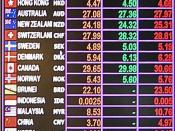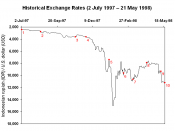Case study 1: the ERM crises of 1992-3
Put simply, as a precursor to full monetary union (the euro), the economies of the EU undertook a period of exchange rate management in order to create convergence and stability before full conversion to the euro. This took the form of the Exchange Rate Mechanism (ERM). It was a hybrid of fixed and floating exchange rates where currencies were allowed to float against each other but within a pre determined band. If currencies moved to the top or bottom of the band, the central banks were committed to intervene in the markets to stay within the band.
The UK was a late member of the ERM, though it had for some years pursued a policy of shadowing the DM. This was because the DM was seen as the strongest and most stable currency in Europe. It would instil in the UK financial discipline, particularly in inflation.
When the UK entered the ERM IN 1990, the ERM was regarded by existing members as a great success, policies had converged and inflation had generally been brought under control.
However,
1. The removal of capital controls in 1991 made currencies vulnerable to speculative attack.
2. The German economy as under strain from unification. The budget deficit was growing rapidly, therefore to keep inflation down, the Bundesbank kept interest rates high.
3. The UK entered the ERM at a rate many thought was unsustainably high. As th UK slid into recession, it was obliged to keep interest rates high to support the pound.
4. The US economy went into recession and interest were cut. Capital found its way to high interest rate countries, notably Germany, pushing the DM higher.
Tensions grew and in September 1992, the Italian Lira was devalued. Two days later (Black Wednesday) 16th...


